By Codi Darnell
September 20, 2022
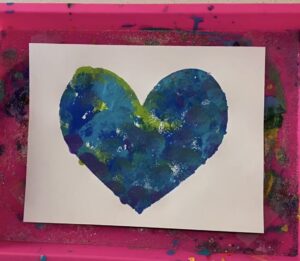 What Are We Going To Do Today?
What Are We Going To Do Today?
If you have woken up and asked yourself this question on a regular basis, you are probably a caregiver. And while a large part of caregiving is based around managing physical needs, there is also a responsibility to engage and stimulate a person mentally and emotionally. This is true across all types of caregiving, including that of dementia.
According to betterhelp.com, there are many benefits to engaging people with dementia in regular activities. Not only can it lead to improved sleep and self-esteem, but it can work to ease depression and decrease the negative effects of behaviour change. On top of all that, it can help you connect with the person you are helping to care for.
Patti LaFleur spent years caring for her mother, Linda, as she battled with dementia. Since Linda passed away earlier this year, Patti has continued to share what she learned as a care partner through her platforms on Instagram and TikTok, a lot of which includes the activities they did together. A familiar name here on our Nerve Matters blog, Patti has contributed to posts in the past, and it was great to connect with her again to compile the four activities below for caregivers to try.
But before you go forth and try to engage in an activity, I recommend you heed Patti’s advice: Process over product and HAVE FUN. Activities are meant to be an enjoyable, shared experience. Connection and stimulation, not perfection, is the goal.
Four Activities for People with Dementia
Sponge Heart Art Project
(for a video demonstration click here)
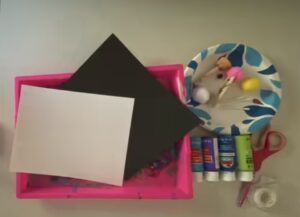 Supplies needed:
Supplies needed:
- Two pieces of paper (one to paint on and one to create the stencil)
- Paint (at least two different colours)
- Plate or cardboard to pour paint on
- Scissors
- Tape
- Brushes (sponge brush, Q-tips, cotton balls or pom poms); have a different brush for every colour of paint
TIP: Attach cotton balls or pom poms to a clothespin to help with fine motor/dexterity.
Directions:
- Fold the stencil piece of paper in half and cut out a heart (or any shape you desire).
- Unfold the stencil and place it overtop the other piece of paper, taping at the corners.
- Pour paint onto plate or cardboard.
- Have the person with dementia dip their brush into the paint and begin to fill the white space of the heart. Continue to fill in all the space with different colours.
- Remove the stencil from overtop and enjoy the creation.
Baby Oil & Water Sensory Bag
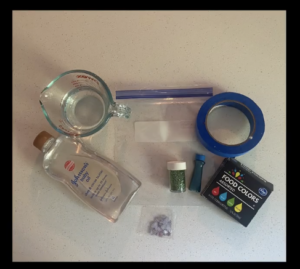 (for a video demonstration click here)
(for a video demonstration click here)
Supplies needed:
- 1/2 cup baby oil
- 1/2 cup water
- Medium Ziploc bag
- Food coloring
- Glitter and/or sequins, etc.
- Masking tape or painter’s tape
Directions:
- Pour the water and baby oil into the Ziploc bag.
- Add glitter, food colouring, sequins, etc.
- Close the bag, squeezing out some of the air
- Tape! Tape over the opening of the bag to avoid accidental spills.
- Have the person with dementia hold, squish and feel the bag.
- Ask questions.
Example questions:
- How does it feel?
- Is it cold?
- Is it hot?
- What shapes do you see?
- Is it squishy?
Picture Books
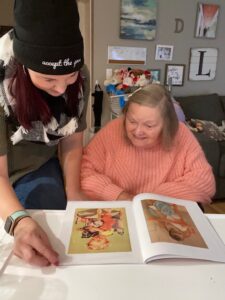 Supplies needed:
Supplies needed:
- Picture book with little to no words. Patti recommends using Nostalgic Picture Book of Babies and others from the Nana’s Books
Directions:
- Sit beside the person living with dementia and let them be in control of the book and as independent with it as possible.
- Ask questions and allow space for them to make observations.
Example questions:
- What do you see?
- How is that person feeling?
- How does this picture make you feel?
- What do you like about it?
Make and Play with Cloud Dough
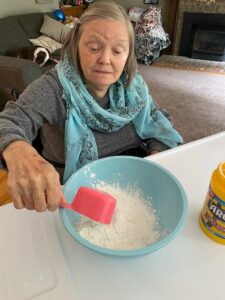 Supplies needed:
Supplies needed:
- 1/3 cup baby lotion or conditioner
- 2/3 cup cornstarch
- Medium mixing bowl
- Food colouring or liquid watercolours (optional)
- Dough tools such as shapes, rollers, and cutters
Directions:
- Mix baby lotion or conditioner and cornstarch together in a medium mixing bowl making sure to keep the 1:2 ratio of baby lotion or conditioner to cornstarch.
- Add food colouring or liquid watercolours if desired.
TIP: Use gloves because until food colouring is properly mixed in, it will stain your hands. - Play! Squish, roll, cut shapes, and ask questions.
Example questions:
- How does it feel?
- What are you making?
- Ask them to make a ball or any other shape.
- Is there something you want me to make?
For information on NervGen Pharma Corp., a clinical stage biotech company dedicated to creating innovative solutions for the treatment of nervous system damage, please follow us at www.nervgen.com.
